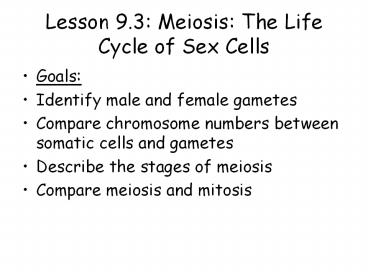Lesson 9.3: Meiosis: The Life Cycle of Sex Cells - PowerPoint PPT Presentation
Title:
Lesson 9.3: Meiosis: The Life Cycle of Sex Cells
Description:
Lesson 9.3: Meiosis: The Life Cycle of Sex Cells Goals: Identify male and female gametes Compare chromosome numbers between somatic cells and gametes – PowerPoint PPT presentation
Number of Views:106
Avg rating:3.0/5.0
Title: Lesson 9.3: Meiosis: The Life Cycle of Sex Cells
1
Lesson 9.3 Meiosis The Life Cycle of Sex Cells
- Goals
- Identify male and female gametes
- Compare chromosome numbers between somatic cells
and gametes - Describe the stages of meiosis
- Compare meiosis and mitosis
2
Meiosis
- Somatic cell body cell which is DIPLOID (2n), -
it has 2 copies of each chromosome (one from mom
and one from dad) these are called HOMOLOGOUS
CHROMOSOMES - In humans, somatic cells have 46 chromosomes
(skin cells, liver cells etc.)
3
Homologous Chromosomes
- Homologous chromosome one of a matching pair of
chromosomes that comes from each parent
Dad
Mom
4
- Gametes, or sex cells do not perform mitosis
- Human sex cells have 23 chromosomes HOW DOES
THIS HAPPEN? - Gametes are involved in sexual reproduction and
are HAPLOID (n) (1 set of chromosomes) - Male gamete sperm
- Female gamete egg
- In humans the sperm and egg each have 23
chromosomes
5
The Phases of Meiosis
- Consists of 2 separate cell divisions named
Meiosis I and Meiosis II - Starts with one diploid cell and ends with FOUR
haploid cells called gametes (sex cells) - During Meiosis I the number of chromosomes is
reduced by ½ therefore meiosis I is known as
reduction - Meiosis II is the same as mitosis (division of
the nucleus)
6
Meiosis I PROPHASE I
- Preceded by Interphase (therefore chromosomes
have replicated ? sister chromatids) - Spindle fibers appear and attach to centromeres
- In meiosis I HOMOLOGOUS chromosomes pair up in a
process called SYNAPSIS which results in TETRADS - While chromosomes are paired, they trade DNA
pieces with each other ? CROSSING OVER
7
Meiosis I Metaphase I
- Tetrads line up randomly along the metaphase
plate (tetrads meet in the middle)
8
Meiosis I Anaphase I
- Homologous chromosome separate move Away/Apart
from one another towards opposite ends of the
cell - Sister chromatids are still together!
9
Meiosis I Telophase I and Cytokinesis
- Each end of the cell now has a haploid nucleus
(nucleus only has one set of chromosomes) - Nuclei and cytoplasm divide in half
- 2 haploid cells form
- Each contains 2 copies of the same set of
chromosomes
10
Meiosis II
- Result 4 haploid (1/2 the number of chromosomes
as the original parent cell), genetically
different cells
- Does not begin with DNA replication
- Prophase II Spindle fibers attach to sister
chromatids - Metaphase II spindle fibers move sister
chromatids to the middle/center - Anaphase II Centromeres divide, sister
chromatids separate and move apart to the poles - Telophase II Nuclear envelope reforms,
cytoplasm divides
11
Lesson 3 Review
- Please read text pages 256-258 and answer the
following questions on page 259 - 1. __________
- 2. __________
- 3. __________
- 4. __________
- 5. __________
- 6. __________
12
Check Mitosis, Meiosis or Both Mitosis Meiosis Both
No pairing of homologous chromosomes
Two divisions
Four daughter cells produced
Associated with growth and asexual reproduction
Associated with sexual reproduction
One division
Two daughter cells produced
Involves duplication of chromosomes
Chromosome maintained
Chromosome is halved
Crossing over between homologous may occur
Daughter cells are identical to parent cell
Daughter cells are not identical to parent cell
Produces gametes
Synapsis occurs in prophase
13
State the Phase (for meiosis - indicate meiosis
I or II)
- Mitosis
- Nucleolus reappears
- Sister chromatids line up at equator
- Cleavage furrow forms
- Cell elongates
- Chromosomes move AWAY from each other
- Spindle fibers stretch across the cell
- Nucleolus and Nuclear membrane disappear
- Meiosis
- Tetrads form
- Crossing over occurs
- Chromatin condenses
- Tetrads line up at equator
- Sister chromatids separate and chromosomes move
AWAY - Centromere divides
- 2 cells are formed
- 4 haploid cells are formed
- Centrioles move to opposite ends of the cell
14
- Review A comparison of mitosis and meiosis
comparison animation































